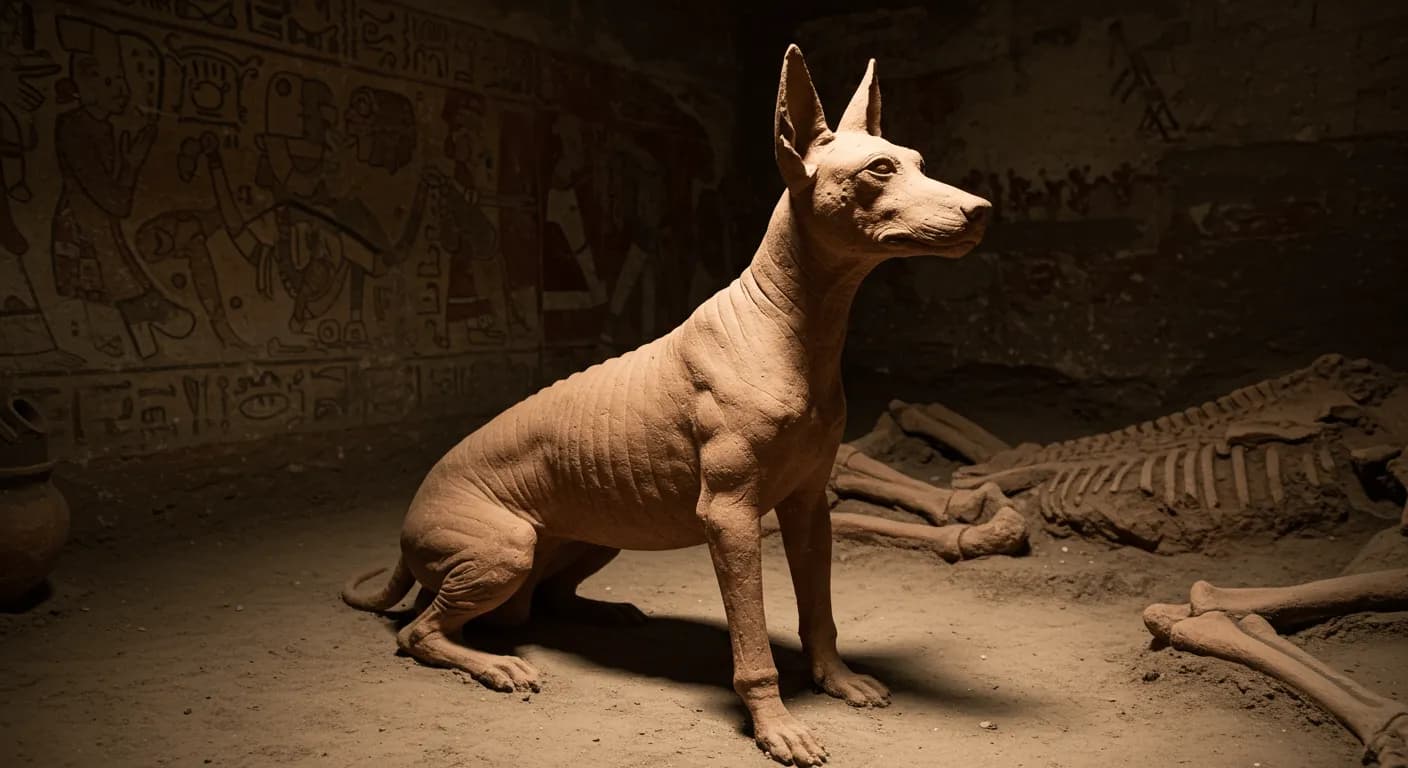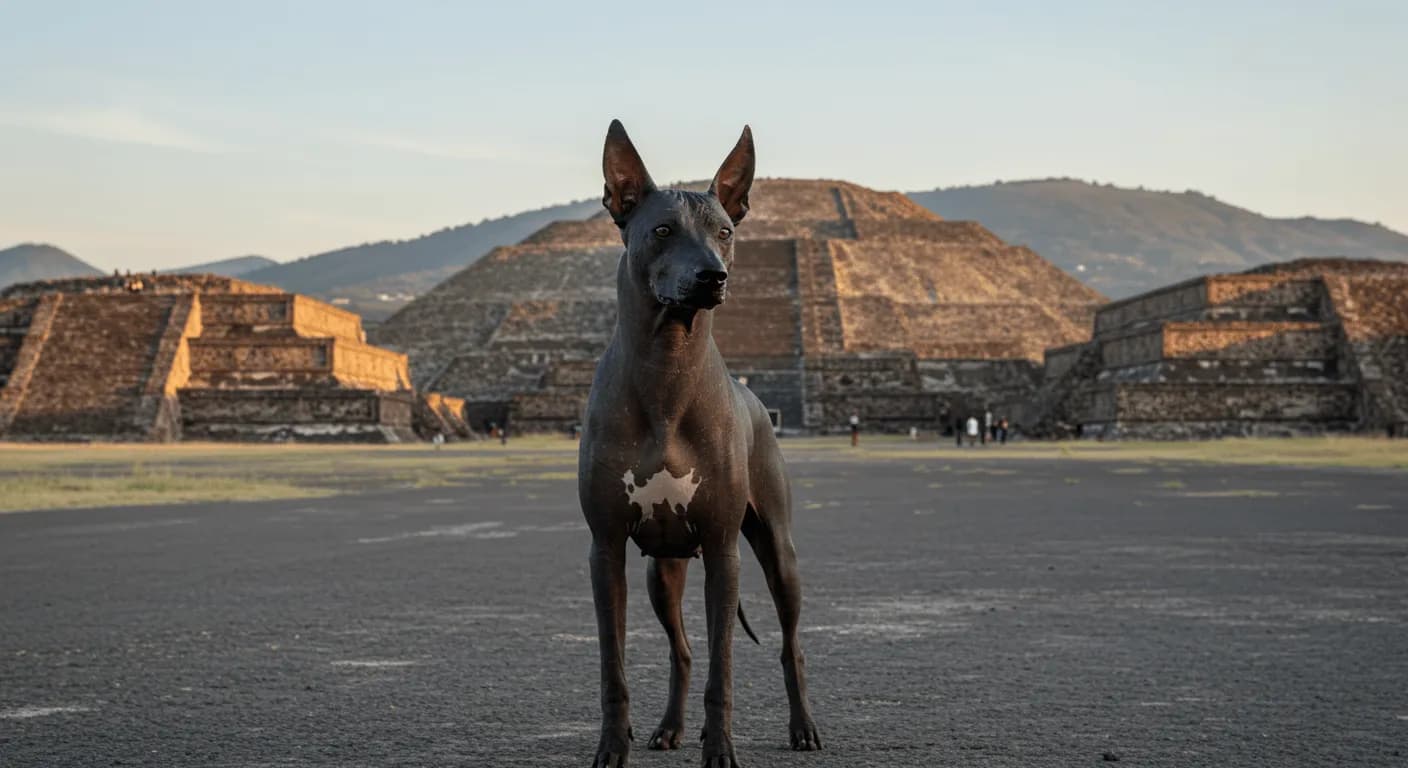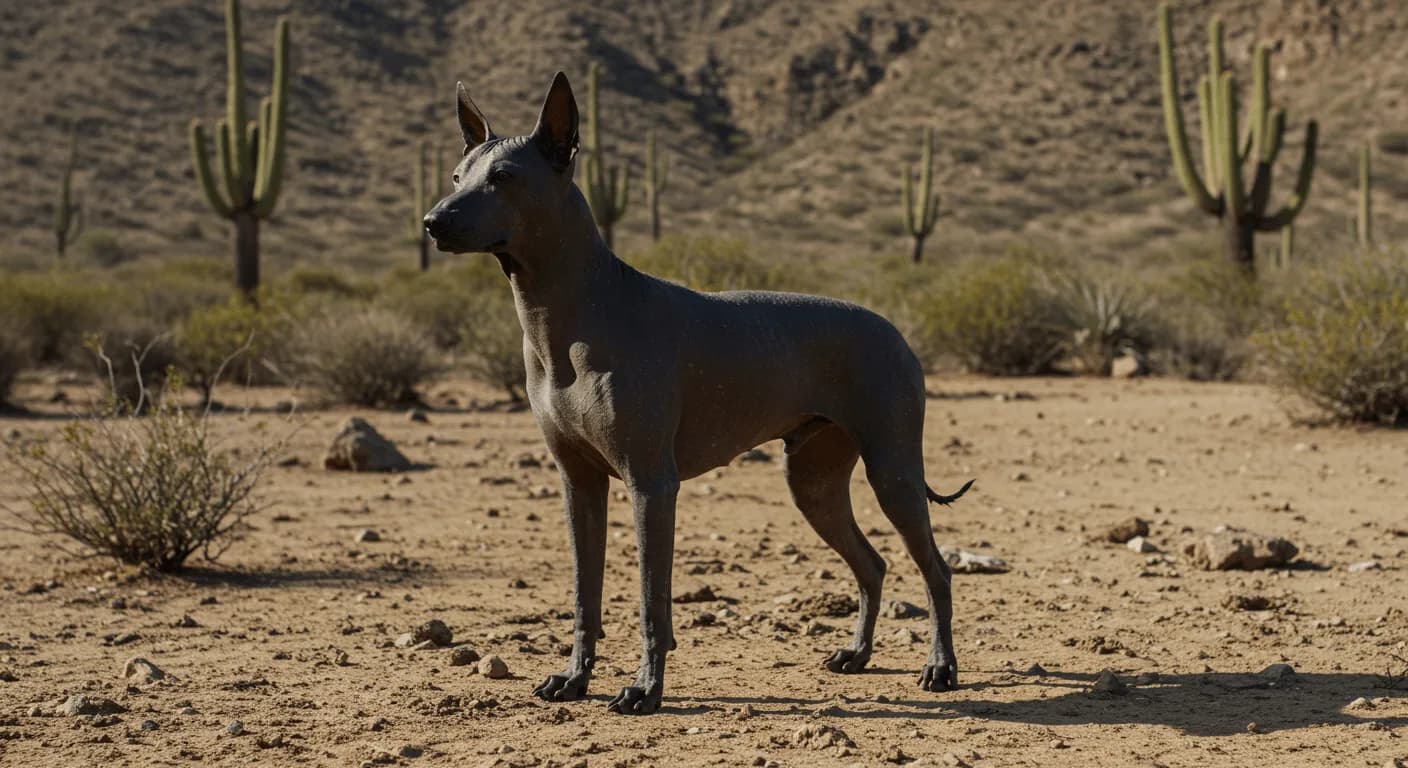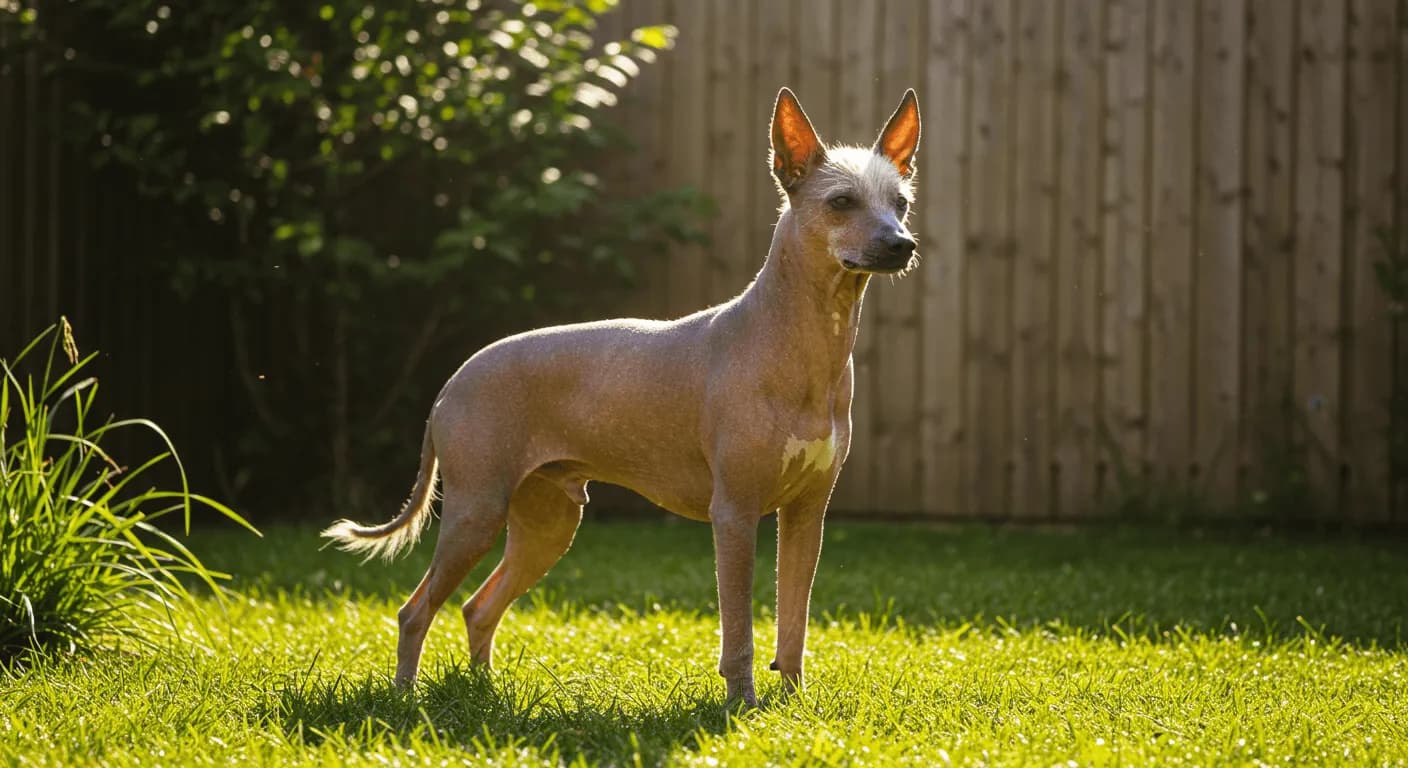The Xoloitzcuintli, often referred to as the “Xolo” (pronounced “shoh-lo”), is one of the world’s oldest and most fascinating breeds. With a history dating back over 3,000 years, this hairless dog of Mesoamerican origin is more than just a companion—it is a living piece of cultural and historical legacy. In this article, we’ll explore the full scope of the Xoloitzcuintli’s past by answering questions like where the Xoloitzcuintli came from, what the Xoloitzcuintli was bred for, how the Xoloitzcuintli was developed, and when the Xoloitzcuintli was first bred. You’ll also learn about Xoloitzcuintli bloodlines history, the etymology and naming roots of the breed, and how it transitioned from ancient temples to modern homes.
Ancient Roots: The Earliest Known Ancestors of the Xoloitzcuintli
The oldest traces of the Xoloitzcuintli can be found in prehistoric Mesoamerica, especially in the regions of present-day Mexico and Central America. Archaeological discoveries reveal that similar hairless dogs existed more than 3,500 years ago, with their images found in Colima, Maya, Toltec, and Aztec artifacts.
The genetic lineage of the Xoloitzcuintli is believed to be ancient and largely untouched due to geographic isolation. DNA analyses link it as a primary aboriginal breed, meaning it developed naturally within a specific region prior to modern breeding science.
- Earliest images of the breed appear in clay effigies and burial pottery in tombs from the Colima culture of Western Mexico, around 1500 BCE.
- Aztec civilization believed the Xolo was a spiritual guide and a guardian of the soul.
- Xolos were believed to have been gifted by the god Xolotl, who gave them to humans to guide them to the underworld.

Where the Xoloitzcuintli Came From
When exploring what country the Xoloitzcuintli came from, the answer is clearly Mexico. It's here that the breed developed in the diverse environments ranging from arid plateaus to tropical forests. The native landscape influenced the Xolo's remarkable traits: minimal grooming needs, excellent thermoregulation through bare skin, and an adaptable, hardy constitution.
The original environment where the Xoloitzcuintli was first developed provided natural selection pressure—only the most disease-resistant, low-maintenance dogs survived. This formed generations of sturdy, intelligent, and emotionally intuitive companions.
Along with early civilizations’ reverence for the breed, they were often allowed to roam freely within households and temples. They weren’t considered wild animals, nor were they entirely domesticated in the way we understand pets today. The Xolo lived in a unique spiritual and social space, solidifying its place in native lore and culture.

Historical Purpose: What the Xoloitzcuintli Was Bred For
One cannot fully appreciate the breed without understanding what the Xoloitzcuintli was bred for. In pre-Columbian civilizations:
- Xolos were guardians of the home—alert, quiet, and strong-willed.
- They were believed to have healing powers; their warm skin was said to relieve conditions like arthritis and asthma.
- Sadly, they were also used as ritual sacrifices and food in some ceremonies—associated with sacred traditions of death and rebirth.
- More importantly, Xolos were spiritual companions, believed to guide the souls of the dead to the afterlife.
Unlike herding or hunting breeds, the Xoloitzcuintli was bred as a versatile, multipurpose companion—spanning roles from guard dog to healer to mystic guide. Its quiet, calm demeanor made it ideal for indoor living, even among ancient Mayan nobility.
How the Xoloitzcuintli Was Developed
Documentation and historical art show that the Xoloitzcuintli evolved naturally over centuries, without the influence of crossbreeding or foreign imports. The breed adapted by natural selection, as those with dominant hairless genes proved advantageous in tropical climates where fleas, ticks, and heat posed threats.
Hairlessness is caused by a mutation in the FOXI3 gene, dominant in Xolos. Still, each litter may contain both coated and hairless pups, illustrating the breed’s unique genetic simplicity and stability. While the world changed around them, Xolos held on to the same traits that made them special to ancient tribes: enduring physical resilience, intuitive emotional intelligence, and a balanced temperament.
- Spanish colonization in the early 16th century nearly drove the breed to extinction. European dogs replaced native ones, and the Xolo slipped into obscurity.
- In the 20th century, especially around the 1950s, efforts by Mexican artists like Diego Rivera and Frida Kahlo helped restore national pride in the Xoloitzcuintli.
- Mexico named the Xoloitzcuintli its official national dog, recognizing its historical and spiritual importance.

The First Known Mentions and International Recognition
The first known mentions of the Xoloitzcuintli trace back to Hernán Cortés, the Spanish conquistador, who noted their presence in Aztec temples and markets. These dogs were part of religious rituals and everyday life in Tenochtitlán and surrounding regions.
Though they had long been part of oral tradition, it wasn’t until 1956 that the Xoloitzcuintli received formal recognition from the Fédération Cynologique Internationale (FCI). The American Kennel Club (AKC) followed suit in 2011, placing the breed in the Non-Sporting Group.
How the Xoloitzcuintli Got Its Name
So, how did the Xoloitzcuintli get its name? The breed’s name derives from the Nahuatl language, spoken by the Aztecs and other indigenous Mesoamerican populations. It is a compound of:
- "Xolotl" – the Aztec god of fire and lightning, often depicted as a dog-headed deity
- "Itzcuintli" – the Nahuatl word for dog
Thus, “Xoloitzcuintli” roughly translates to “the dog of Xolotl” or “Xolotl’s dog.” The name is deeply tied to the breed's mythological roots, spiritual symbolism, and revered status in indigenous mythology.
Over time, the name has evolved with various colloquial shortenings:
- “Xolo” (common even today)
- “Mexican Hairless Dog”
Naming conventions carried high cultural meanings. To name a dog “Xoloitzcuintli” was to associate it with divine guidance and spiritual protection.
Xoloitzcuintli Bloodlines History
Over the last few centuries, Xoloitzcuintli bloodlines history has been a blend of preservation and rediscovery. In the early 20th century:
- Continued sightings of Xolos in remote Mexican and Central American villages piqued the interest of ethnographers and canine enthusiasts.
- A coordinated effort in the 1950s brought dogs from these regions into conservation programs, focusing on maintaining genetic purity while strengthening traits that epitomize the breed: intelligence, calmness, and adaptability.
Although many breeds have shifted in physical structure over time due to show trends and performance demands, the Xoloitzcuintli remains one of the most unadulterated breeds, free from heavy genetic manipulation. Modern breeding programs strive to retain this ancient nobility.
When the Xoloitzcuintli Came to America
Understanding when the Xoloitzcuintli came to America offers insight into how the breed’s legacy extended beyond Mesoamerica. It was in the early 20th century, particularly the 1930s and 1940s, when interest grew in unusual and rare breeds. American travelers and collectors who visited rural regions of Mexico occasionally brought Xolos back to the United States.
However, it wasn’t until the breed appeared in Westminster Kennel Club shows in the 1940s that formal interest mounted. Today, the Xolo is found across the Americas and Europe, continuing to enchant dog lovers with its dignity and ancient charm.
Cultural Significance and Societal Influence
The Xoloitzcuintli has contributed more than companionship—it has shaped human understanding of life, death, and the natural world. Particularly in Mesoamerican belief systems, the Xolo was:
- A medium through which humans communicatd with the spiritual realm
- A living muse for artists and philosophers
- A healing presence in both physical and emotional senses
Its image continues to be invoked in festivals like Dia de los Muertos (Day of the Dead), in sculptures and murals throughout Mexico City, and in modern media such as Pixar’s Coco, contributing to renewed global interest.
Here are a few highlights of the breed’s modern-day cultural relevance:
- The Xolo appears in statues and murals across Mexican public spaces.
- It’s a frequent symbol in tattoo art and indigenous heritage representation.
- It represents resilience, purity, and national pride for many Mexicans.
Key Milestones in Xoloitzcuintli History
To recap the major historical events in the breed’s development, here is a summary timeline:
- 1500 BCE – Earliest depictions in Colima pottery
- 700 CE – Widespread cultural presence among Maya and Toltecs
- 1519 – Hernán Cortés documents Xolos in Tenochtitlán
- 1950s – Mexican government initiates breed recovery
- 1956 – Recognized by Fédération Cynologique Internationale
- 2011 – Officially accepted by the American Kennel Club
Fun Facts About the Xoloitzcuintli
- Xolos are considered hypoallergenic due to their hairlessness.
- They come in three sizes: toy, miniature, and standard.
- Some Xolos are born with a coat, and they’re still recognized as purebred.
- Xoloitzcuintli footprints have been found fossilized along with early Mesoamerican human remains.
Characteristics That Shaped an Icon
Why has the Xolo stood the test of time? Here are the defining traits rooted in its origin:
- Naturally aloof with strangers, intensely loyal to family
- Low-maintenance grooming and hardy skin
- Almost silent, often observant and sensitive to human emotions
- Heat-emitting body made it a "living hot water bottle" in ancient times
As breed enthusiasts continue to study and celebrate Xoloitzcuintli history and origin, one thing is clear: this dog’s lineage is not just a scientific interest but a testament to human-animal connection across millennia.## Conclusion
The Xoloitzcuintli is far more than a unique hairless dog—it is a bridge to humanity’s ancient past, a symbol of cultural survival, and an enduring companion that has walked alongside civilizations for over three millennia. From its sacred role in guiding souls through the Aztec underworld to its renaissance as a national treasure and modern family pet, the Xolo embodies resilience, spirituality, and timeless beauty.
As we continue to learn about the Xoloitzcuintli history and origin, we deepen our appreciation for a breed that has remained faithful not just to its people, but to its purpose. Whether admired for its elegant silhouette, revered for its sacred past, or cherished for its quiet companionship, the Xoloitzcuintli remains one of the most remarkable dogs in history—a living legacy of Mexico’s deep cultural roots and humanity’s enduring bond with man’s best friend.


